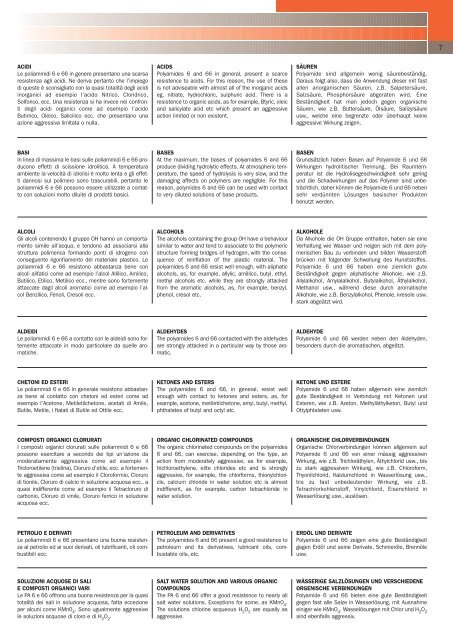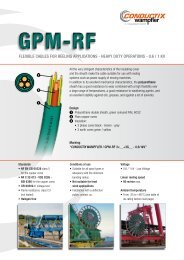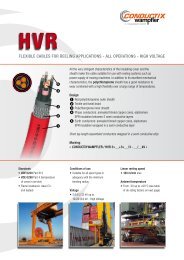conductix operations
conductix operations
conductix operations
Create successful ePaper yourself
Turn your PDF publications into a flip-book with our unique Google optimized e-Paper software.
01-37 PORTAC 04 IT-ING-TED 14-03-2006 8:58 Pagina 7<br />
ACIDI<br />
Le poliammidi 6 e 66 in genere presentano una scarsa<br />
resistenza agli acidi. Ne deriva pertanto che l’impiego<br />
di queste è sconsigliato con la quasi totalità degli acidi<br />
inorganici ad esempio l’acido Nitrico, Cloridrico,<br />
Solforico, ecc. Una resistenza si ha invece nei confronti<br />
degli acidi organici come ad esempio l’acido<br />
Butirrico, Oleico, Salicilico ecc. che presentano una<br />
azione aggressiva limitata o nulla.<br />
BASI<br />
In linea di massima le basi sulle poliammidi 6 e 66 producono<br />
effetti di scissione idrolitica. A temperatura<br />
ambiente la velocità di idrolisi è molto lenta e gli effetti<br />
dannosi sul polimero sono trascurabili, pertanto le<br />
poliammidi 6 e 66 possono essere utilizzate a contatto<br />
con soluzioni molto diluite di prodotti basici.<br />
ALCOLI<br />
Gli alcoli contenendo il gruppo OH hanno un comportamento<br />
simile all’acqua, e tendono ad associarsi alla<br />
struttura polimerica formando ponti di idrogeno con<br />
conseguente rigonfiamento del materiale plastico. Le<br />
poliammidi 6 e 66 resistono abbastanza bene con<br />
alcoli alifatici come ad esempio l’alcol Allilico, Amilico,<br />
Butilico, Etilico, Metilico ecc., mentre sono fortemente<br />
attaccate dagli alcoli aromatici come ad esempio l’alcol<br />
Benzilico, Fenoli, Cresoli ecc.<br />
ALDEIDI<br />
Le poliammidi 6 e 66 a contatto con le aldeidi sono fortemente<br />
attaccate in modo particolare da quelle aromatiche.<br />
CHETONI ED ESTERI<br />
Le poliammidi 6 e 66 in generale resistono abbastanza<br />
bene al contatto con chetoni ed esteri come ad<br />
esempio l’Acetone, Metiletilchetone, acetati di Amile,<br />
Butile, Metile, i ftalati di Butile ed Ottile ecc.<br />
COMPOSTI ORGANICI CLORURATI<br />
I composti organici clorurati sulle poliammidi 6 e 66<br />
possono esercitare a secondo dei tipi un’azione da<br />
moderatamente aggressiva come ad esempio il<br />
Tricloroetilene (trielina), Cloruro d’etile, ecc. a fortemente<br />
aggressiva come ad esempio il Cloroformio, Cloruro<br />
di tionile, Cloruro di calcio in soluzione acquosa ecc., a<br />
quasi indifferente come ad esempio il Tetracloruro di<br />
carbonio, Cloruro di vinile, Cloruro ferrico in soluzione<br />
acquosa ecc.<br />
PETROLIO E DERIVATI<br />
Le poliammidi 6 e 66 presentano una buona resistenza<br />
al petrolio ed ai suoi derivati, oli lubrificanti, oli combustibili<br />
ecc.<br />
SOLUZIONI ACQUOSE DI SALI<br />
E COMPOSTI ORGANICI VARI<br />
Le PA 6 e 66 offrono una buona resistenza per la quasi<br />
totalità dei sali in soluzione acquosa, fatta eccezione<br />
per alcuni come KMn0 4 . Sono ugualmente aggressive<br />
le soluzioni acquose di cloro e di H 2 O 2 .<br />
ACIDS<br />
Polyamides 6 and 66 in general, present a scarce<br />
resistence to acids. For this reason, the use of these<br />
is not adviseable with almost all of the inorganic acids<br />
eg. nitrate, hydrochloric, sulphuric acid. There is a<br />
resistence to organic acids, as for example, Btyric, oleic<br />
and salicylate acid etc which present an aggressive<br />
action limited or non existent.<br />
BASES<br />
At the maximum, the bases of polyamides 6 and 66<br />
produce dividing hydrolytic effects. At atmospheric temperature,<br />
the speed of hydrolysis is very slow, and the<br />
damaging affects on polymers are negligible. For this<br />
reason, polymides 6 and 66 can be used with contact<br />
to very diluted solutions of base products.<br />
ALCOHOLS<br />
The alcohols containing the group OH have a behaviour<br />
similar to water and tend to associate to the polymeric<br />
structure forming bridges of hydrogen, with the consequence<br />
of reinflation of the plastic material. The<br />
polyamides 6 and 66 resist well enough, with aliphatic<br />
alcohols, as, for example, allylic, amillico, butyl, ethyl,<br />
methyl alcohols etc. while they are strongly attacked<br />
from the aromatic alcohols, as, for example, benzyl,<br />
phenol, cresol etc.<br />
ALDEHYDES<br />
The polyamides 6 and 66 contacted with the aldehydes<br />
are strongly attacked in a particular way by those aromatic.<br />
KETONES AND ESTERS<br />
The polyamides 6 and 66, in general, resist well<br />
enough with contact to ketones and esters, as, for<br />
example, acetone, metiletilchetone, amyl, butyl, methyl,<br />
phthalates of butyl and octyl atc.<br />
ORGANIC CHLORINATED COMPOUNDS<br />
The organic chlorinated compounds on the polyamides<br />
6 and 66, can exercise, depending on the type, an<br />
action from moderately aggressive, as for example,<br />
trichloroethylene, elite chlorides etc and is strongly<br />
aggressive, for example, the chlorforms, thionylchloricle,<br />
calcium chloride in water solution etc is almost<br />
indifferent, as for example, carbon tetrachloride in<br />
water solution.<br />
PETROLEUM AND DERIVATIVES<br />
The polyamides 6 and 66 present a good resistence to<br />
petroleum and its derivatives, lubricant oils, combustable<br />
oils, etc.<br />
SALT WATER SOLUTION AND VARIOUS ORGANIC<br />
COMPOUNDS<br />
The PA 6 and 66 offer a good resistence to nearly all<br />
salt water solutions. Exceptions for some, as KMn0 4 .<br />
The solutions chlorine acqueous H 2 O 2 are equally as<br />
aggressive.<br />
SÄUREN<br />
Polyamide sind allgemein wenig säurebeständig.<br />
Daraus folgt also, dass die Anwendung dieser mit fast<br />
allen anorganischen Säuren, z.B. Salpetersäure,<br />
Salzsäure, Phosphorsäure abgeraten wird. Eine<br />
Beständigkeit hat man jedoch gegen organische<br />
Säuren, wie z.B. Buttersäure, Ölsäure, Salizylsäure<br />
usw., welche eine begrenzte oder überhaupt keine<br />
aggressive Wirkung zeigen.<br />
BASEN<br />
Grundsätzlich haben Basen auf Polyamide 6 und 66<br />
Wirkungen hydrolitischer Trennung. Bei Raumtemperatur<br />
ist die Hydrolisegeschwindigkeit sehr gering<br />
und die Schadwirkungen auf das Polymer sind unbeträchtlich,<br />
daher können die Polyamide 6 und 66 neben<br />
sehr verdünnten Lösungen basischer Produkten<br />
benutzt werden.<br />
ALKOHOLE<br />
Da Alkohole die OH Gruppe enthalten, haben sie eine<br />
Verhaltung wie Wasser und neigen sich mit dem polymerischen<br />
Bau zu verbinden und bilden Wasserstoffbrücken<br />
mit folgender Schwellung des Kunststoffes.<br />
Polyamide 6 und 66 haben eine ziemlich gute<br />
Beständigkeit gegen aliphatische Alkohole, wie z.B.<br />
Allylalkohol, Amylalalkohol, Butylalkohol, Äthylalkohol,<br />
Methanol usw., während diese durch aromatische<br />
Alkohole, wie z.B. Benzylalkohol, Phenole, kresole usw.<br />
stark abgeätzt wird.<br />
ALDEHYDE<br />
Polyamide 6 und 66 werden neben den Aldehyden,<br />
besonders durch die aromatischen, abgeätzt.<br />
KETONE UND ESTERE<br />
Polyamide 6 und 66 haben allgemein eine ziemlich<br />
gute Beständigkeit in Verbindung mit Ketonen und<br />
Esteren, wie z.B. Azeton, Methyläthylketon, Butyl und<br />
Ottylphtalaten usw.<br />
ORGANISCHE CHLORVERBINDUNGEN<br />
Organische Chlorverbindungen können allgemein auf<br />
Polyamide 6 und 66 von einer mässig aggressiven<br />
Wirkung, wie z.B. Trichloräthylen, Äthylchlorid usw., bis<br />
zu stark aggressiven Wirkung, wie z.B. Chloroform,<br />
Thyonilchlorid, Kalziumchlorid in Wasserlösung usw.,<br />
bis zu fast unbedeutender Wirkung, wie z.B.<br />
Tetrachlorkohlenstoff, Vinylchlorid, Eisenchlorid in<br />
Wasserlösung usw., auslösen.<br />
ERDÖL UND DERIVATE<br />
Polyamide 6 und 66 zeigen eine gute Beständigkeit<br />
gegen Erdöl und seine Derivate, Schmieröle, Brennöle<br />
usw.<br />
WÄSSERIGE SALZLÖSUNGEN UND VERSCHIEDENE<br />
ORGENISCHE VERBINDUNGEN<br />
Polyamide 6 und 66 bieten eine gute Beständigkeit<br />
gegen fast alle Salze in Wasserlösung, mit Ausnahme<br />
einiger wie KMnO 4 . Wasselösungen mit Chlor und H 2 O 2<br />
sind ebenfalls aggressiv.<br />
7












